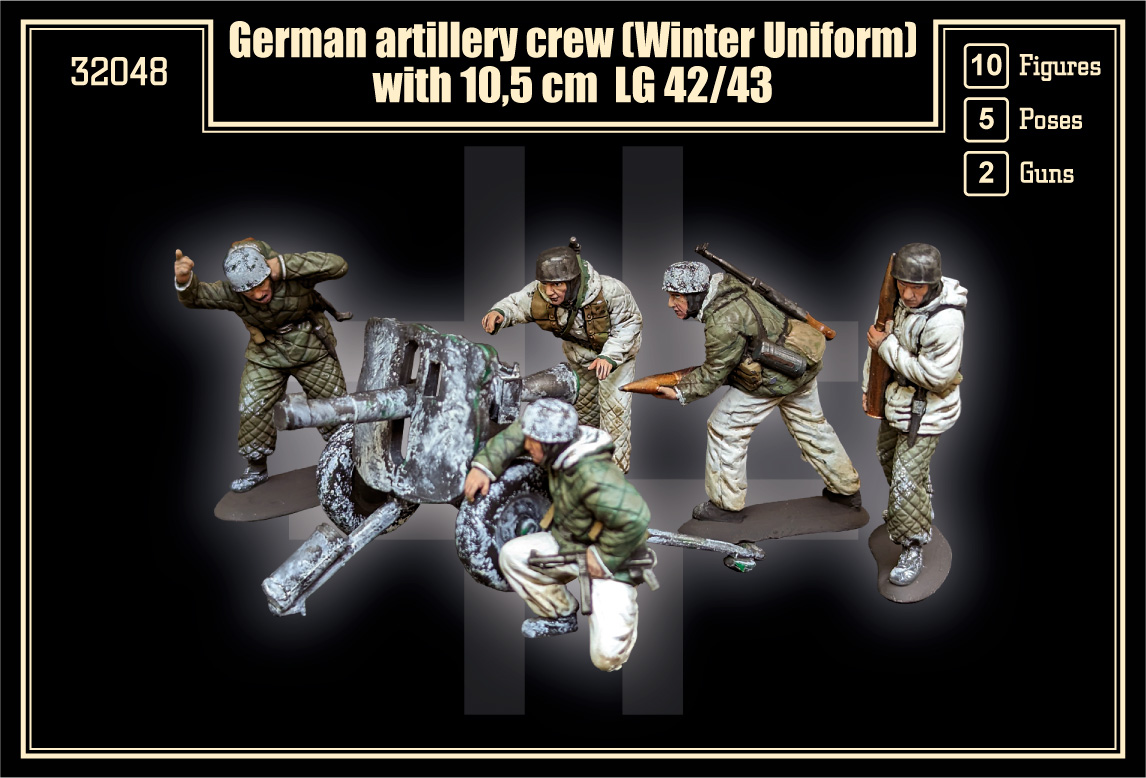Mars 1/32 German Paratroopers Crew (Winter Uniform) with LG 42/43 Gun # 32048
During World War II, German paratroopers, known as Fallschirmjäger, were elite airborne infantry units of the Luftwaffe.
Renowned for their daring operations and combat effectiveness, these troops played a significant role in various theaters of war.
In the harsh winter conditions of the Eastern Front and other cold climates, they were equipped with specialized winter uniforms and gear.
Among the weapons they employed was the LG 42/43 (Leichtgeschütz 42/43), a lightweight recoilless gun designed for infantry use.
Winter Uniform
The winter uniform of German paratroopers was designed to provide warmth and functionality in freezing temperatures while maintaining combat readiness:
Winter Parka: A heavy, insulated parka with a fur-lined hood, often reversible with one side white for snow camouflage and the other side field gray or splinter camouflage.
Winter Trousers: Insulated trousers, often lined with wool or fur, designed to protect against the cold. These were also reversible for camouflage purposes.
Headgear: Woolen caps or helmets with additional covers for insulation, including field caps with ear flaps and fur-lined caps.
Footwear: Insulated and waterproof boots, often lined with felt or fur. Soldiers also used over-boots or gaiters to keep snow out and provide additional warmth.
Gloves and Mittens: Woolen gloves and mittens, sometimes with leather reinforcements, to protect hands from the cold while allowing for weapon handling.
Scarves and Face Masks: Woolen scarves and face masks to protect the face and neck from the biting cold winds.
LG 42/43 Gun
The LG 42/43 was a series of recoilless guns developed by Germany during World War II.
These lightweight guns were designed to provide infantry units with a powerful, portable weapon capable of engaging armored vehicles and fortifications.
Design and Features:Caliber: The LG 42/43 guns typically had a caliber of 105 mm.
Recoil System: Utilizing a recoilless firing system, the LG 42/43 expelled gas out the back of the gun to counteract the recoil, allowing for a lighter structure and easier transport.
Portability: The gun's lightweight design enabled it to be manned and transported by a small crew, often consisting of three to four soldiers.
Ammunition: It fired high-explosive (HE) and high-explosive anti-tank (HEAT) rounds, effective against both fortifications and armored targets.
Crew Operations
A typical crew operating the LG 42/43 gun in winter conditions would follow specific procedures to ensure efficiency and effectiveness:
Deployment: The crew would deploy the gun in a strategic position, often using natural cover and camouflage to conceal their location. Snow camouflage nets and white coverings were commonly used.
Ammunition Handling: One or two crew members were responsible for handling and loading ammunition. In winter, extra care was taken to keep the rounds dry and free from ice or snow.
Gun Operation: The gunner aimed and fired the weapon, using the recoil-free design to maintain accuracy. Adjustments for wind, temperature, and target movement were critical in winter conditions.
Support and Logistics: Additional crew members provided support by spotting targets, relaying commands, and ensuring communication with higher command. They also assisted in transporting and setting up the gun, especially challenging in deep snow or icy terrain.
Challenges and Adaptations
Operating in winter conditions presented numerous challenges for German paratroopers and their equipment:
Cold Weather Impact: Extreme cold affected both personnel and equipment, necessitating rigorous maintenance routines to prevent malfunctions due to ice and cold.
Mobility: Moving through snow and ice was physically demanding. The crew had to be in excellent physical condition and use skis, sleds, or other means to transport the gun and supplies.
Camouflage and Concealment: Winter camouflage was essential to avoid detection. The crew used white uniforms and camouflage nets to blend into the snowy landscape.
Combat Effectiveness
Despite the harsh conditions, German paratroopers equipped with the LG 42/43 gun were formidable opponents. Their ability to quickly deploy and effectively use this powerful weapon provided significant tactical advantages, especially in ambushes and defensive operations against both infantry and armored targets.
Legacy
The use of German paratroopers with the LG 42/43 gun in winter conditions exemplified their adaptability and combat prowess.
Their experiences contributed to the development of airborne and light infantry tactics and underscored the importance of specialized equipment and training for operations in extreme environments.



















 Spread the cost with Paypal Credit
Spread the cost with Paypal Credit
 Spread the cost with Klarna
Spread the cost with Klarna









